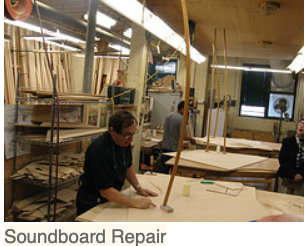A Trip to the Steinway Factory
Apr 27, 2010
Today was nothing short of a thrill. A pianist’s trip to Mecca. The Garth Newel Music Center, located in Warm Springs, VA and home to a resident piano quartet, is looking for a brand new Steinway D. I was very flattered that they asked me to accompany them (the string players, some administrators, and some of the generous friends and patrons helping to fund the purchase of the instrument) to New York for a visit to the Steinway Factory, located in Astoria, NY.
The morning began with a tour of the inside of the factory. Steinway is widely accepted as the most finely made and best sounding piano around for centuries. They are proud of their heritage and their position of esteem in the piano world, and rightly so. The first part of the tour was perhaps the most dramatic. We got to watch the creation of the rounded piano case. Long strips of rock-hard maple were fed through a machine which coated them with a special glue. It takes eight strips of laminate glued together to create the inside rim of the piano, and another nine strips to make the actual outside case of the piano. Steinway is apparently the only piano manufacturer that bends the inner frame and the outer frame together at the same time, creating better strength and cohesion. After the 17 strips of laminate became one 300 pound timber of wood, that timber was taken, carried by at least six men, over to the rim press. It was unbelievable to watch as the wood was bent into the shape of the piano frame, and was then held in place by huge iron vices. We onlookers were even invited to participate in the process of helping to tighten the screws that hold the vices onto the wood frame. I helped bend the rim on a brand new Steinway D! It stays there in the press overnight and then gets taken to a drying room, where it spends 4 months in a very hot, very humid environment which smells strongly of formaldehyde based glue.
Next we visited the veneer room. A sign over the door proclaimed “Crown Jewel Veneer Room.” Here we learned that the veneer of every piano comes from one single tree. That is the only way to create pieces of veneer that match perfectly. The pieces are carefully selected (by eye, not by robot or computer) and glued together. The most amazing piece of information I learned in this room is that when a piano is made, the veneer from that particular tree is labeled and saved. There was 1.5 million dollars worth of wood in that room! When a piano falls into disrepair and needs veneer work done, the wood from the very tree that was used for the original can be looked up, found, and that wood is then used for repairs. Our tour guide, the lovely and informative Nicole Martini, told us a story of a piano built in the late 1800’s which needed veneer work done, and they were able to locate the very material that was used for the original veneer. Incredible.
The soundboard room was also fascinating. Wood for soundboards is chosen from a special forest, the Sitka Forest in Alaska, with which Steinway has had a relationship for a hundred years. 150 year old spruce trees are selected from this forest. There is apparently C grade wood, B grade wood, A grade wood… and then there is Steinway grade wood! Once the wood arrives and is assembled into the soundboard, an artisan in this room examines each one for any tiny blemish, crack or crevice, removes it with a special tool, cuts wood from another matching piece of wood, and fills the hole seamlessly. The tiny piece of wood is glued in place and held there with a long bowed stick which is leveraged against the ceiling to produce 500 pounds of pressure on the glued area to assure cohesion.
We visited the drying room, where piano rims stand vertically, row upon row, and so tall you can stand in them. The pounding room was also a revelation – a special machine depresses all the keys at once, to loosen up the action of the piano and I suppose to start the breaking in process. (Any new piano requires at least 50 hours of playing time before it is truly broken in.)
The level of craftsmanship is undeniable and unbelievable. In a world that values quick, cheap, mass production, it was truly astounding to realize the level of by hand artisanship that is still being practiced in this factory, day after day. And as a pianist who spends every day of my life playing these instruments, it was fascinating and truly exhilarating to see the process by which they are born.


